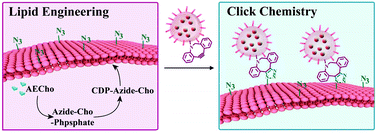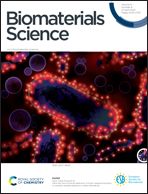Two-step tumor-targeting therapy via integrating metabolic lipid-engineering with in situ click chemistry†
Abstract
Highly efficient tumor-targeted therapy remains a great challenge due to the complexity and heterogeneity of tumor tissues. Herein, we developed an in vivo two-step tumor-targeting strategy by combining metabolic lipid-engineering with a stain-promoted azide–alkyne 1,3-dipolar cycloaddition (SPAAC) reaction, independent of the tumor microenvironment and cell phenotype. Firstly, exogenously-supplied azidoethyl-cholines (AECho) were metabolically incorporated into the cell membranes in tumor tissues through the intrinsic biosynthesis of phosphatidylcholine. The pre-inserted and accumulated azido groups (N3) could subsequently serve as ‘artificial chemical receptors’ for the specific anchoring of dibenzocyclooctyne (DBCO) modified biomimetic nanoparticles (DBCO-RBCG@ICG) via in situ click chemistry, resulting in significantly enhanced tumor-targeting and then an improved photothermal therapy effect. Such a two-step targeting strategy based on these cutting-edge techniques provided new insights into the universal and precise functionalization of living tissues for site-specific drug delivery in the diagnosis and treatment of various diseases.



 Please wait while we load your content...
Please wait while we load your content...